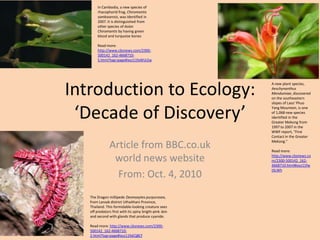
Ecology: Levels of Organization
- 1. Introduction to Ecology: ‘Decade of Discovery’ Article from BBC.co.ukworld news website From: Oct. 4, 2010 In Cambodia, a new species of rhacophorid frog, Chiromantissamkosensis, was identified in 2007. It is distinguished from other species of Asian Chiromantis by having green blood and turquoise bonesRead more: http://www.cbsnews.com/2300-500142_162-4668710-5.html?tag=page#ixzz11fxWUi2w A new plant species, AeschynanthusMendumiae, discovered on the southeastern slopes of Laos' Phuo Yang Mountain, is one of 1,068 new species identified in the Greater Mekong from 1997 to 2007 in the WWF report, "First Contact in the Greater Mekong."Read more: http://www.cbsnews.com/2300-500142_162-4668710.html#ixzz11fwtSLWh The Dragon millipede Desmoxytespurpurosea, from Lansak district Uthaithani Province, Thailand. This formidable-looking creature sees off predators first with its spiny bright-pink skin and second with glands that produce cyanide.Read more: http://www.cbsnews.com/2300-500142_162-4668710-2.html?tag=page#ixzz11fxEQ8Cf
- 2. Ecology is the study of the relationships between the natural world and all the living and non-living things in that environment
- 3. Article Information This article tells us about a research study completed on the FIRST census of marine life Involved almost 3000 researchers from 80 different countries, and over 9000 days at sea! Key questions: What LIVED in the oceans? What DOES live in the oceans? What WILL live in the oceans?
- 4. Discovered many species thought to be rare Collected many specimens and are identifying almost 6000 new species! Oceans are changing quickly, so it is important to know what lives there Questions to consider: Do you think this is an important study? Why/why not? Explain. Now that we have more knowledge about the oceans and the life found in oceans, what should we do with this information? This member of the new Kiwaidae family of crabs, discovered near Easter Island, was named Kiwahirsuta because of its furry appearance. From:http://news.bbc.co.uk/2/hi/science/nature/8523389.stm This new sponge produces a chemical with anti-cancer propertiesFrom: http://news.bbc.co.uk/2/hi/science/nature/8523389.stm
- 5. Levels of organization in Ecology Biosphere Ecosystem Community Population Individual (species)
- 7. POPULATION A population is made of many of the SAME KIND of species that live in the same area Compete with each other for food, mates, water and space Examples Population of trout in a river Population of bats living in a cave Population of GI students in the classroom
- 8. COMMUNITY A community is made of many groups of populations that interact in an area Examples: A forest: populations of trees, populations of mushrooms, populations of birds A lake: populations of insects, populations of fish, populations of algae
- 9. ECOSYSTEM An ecosystem includes all the living organisms in an area and all the non- living things that affect it Examples: Forest ecosystem includes grass, soil, wind, sunlight, animals Ocean ecosystem includes fish, coral, rocks at the bottom, temperature of water
- 10. BIOSPHERE The part of the Earth that supports all organisms, made up of all of the Earth’s ecosystems Examples: Made up of the water, land, living things and air
- 12. Oct.20/21 Science Journal SJ: Why do you think the ecological model (in the note today) is a picture of circles within circles?
Notes de l'éditeur
- A census is a survey taken to gather information about a certain group – marine life!